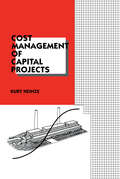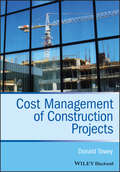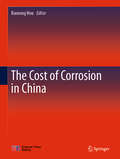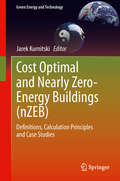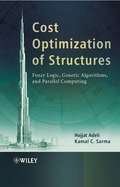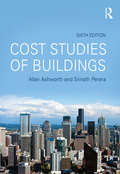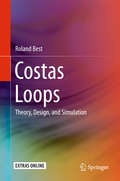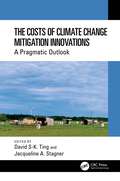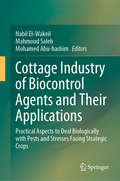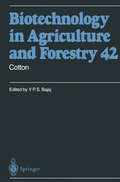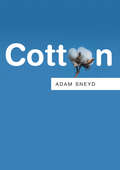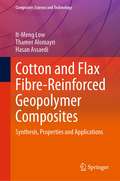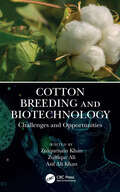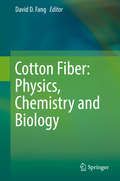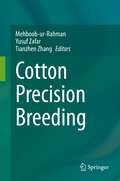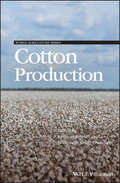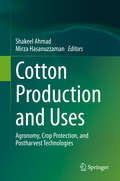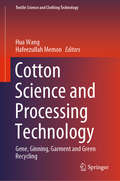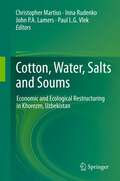- Table View
- List View
Cost Management of Capital Projects (Cost Engineering)
by Kurt HeinzeAiming to bridge the gap between the quantitative viewpoint of management science and the practical, day-to-day needs of project cost management, this text offers coverage of an integrated cost management programme. It presents the use of method study techniques to increase the effectiveness of procedures and improve the productivity of resources, emphasizing a systematic approach to cost control.
Cost Management of Capital Projects (Cost Engineering #27)
by Kurt HeinzeAiming to bridge the gap between the quantitative viewpoint of management science and the practical, day-to-day needs of project cost management, this text offers coverage of an integrated cost management programme. It presents the use of method study techniques to increase the effectiveness of procedures and improve the productivity of resources, emphasizing a systematic approach to cost control.
Cost Management of Construction Projects
by Donald ToweyThe cost manager/quantity surveyor plays a pivotal role in the financial and contract management of construction projects, although the exact nature of the service they provide depends on the project employer’s terms of engagement. This can mean acting as consultant in a range of roles including cost and advisory services for budget setting to initiate a project, cost management through the design and construction phases, contract administration and acting as the client side project manager to oversee the entire building process. Cost Management of Construction Projects focusses on the cost manager/quantity surveyor engaged by the project client, and discusses key elements that help drive project success including measurement (based on the New Rules of Measurement published by RICS), procurement, cost planning, contract administration and project cost management. With examples, it provides a thorough guide to the role in the workplace and in the field, directly addressing the day to day situations faced by the cost manager/quantity surveyor. Donald Towey MRICS has extensive experience of the construction industry. His experience began as an estimator with a glass/glazing contractor in Manchester. Following a number of positions with UK contractors he relocated to Australia and has worked with a number of developers and main contractors, as well as doing freelance work. He is currently working in contracts management in Sydney.
Cost Management of Construction Projects
by Donald ToweyThe cost manager/quantity surveyor plays a pivotal role in the financial and contract management of construction projects, although the exact nature of the service they provide depends on the project employer’s terms of engagement. This can mean acting as consultant in a range of roles including cost and advisory services for budget setting to initiate a project, cost management through the design and construction phases, contract administration and acting as the client side project manager to oversee the entire building process. Cost Management of Construction Projects focusses on the cost manager/quantity surveyor engaged by the project client, and discusses key elements that help drive project success including measurement (based on the New Rules of Measurement published by RICS), procurement, cost planning, contract administration and project cost management. With examples, it provides a thorough guide to the role in the workplace and in the field, directly addressing the day to day situations faced by the cost manager/quantity surveyor. Donald Towey MRICS has extensive experience of the construction industry. His experience began as an estimator with a glass/glazing contractor in Manchester. Following a number of positions with UK contractors he relocated to Australia and has worked with a number of developers and main contractors, as well as doing freelance work. He is currently working in contracts management in Sydney.
The Cost of Corrosion in China
by Baorong HouThis book comprehensively covers corrosion and corrosion protection in China in the areas including infrastructure, transportation, energy, water environment, as well as manufacturing and public utilities. Furthermore, it presents a major consulting project of Chinese Academy of Engineering, which was the largest corrosion investigation project in Chinese history, including the corresponding methods, processes and corrosion protection strategies, and provides valuable information for numerous industries. Sharing essential insights into corrosion prediction and decision-making, this book will help to decrease costs and extend the service life of equipment and facilities; accordingly, it will benefit scientists and engineers working on corrosion research and protection, as well as economists and government employees.
Cost Optimal and Nearly Zero-Energy Buildings: Definitions, Calculation Principles and Case Studies (Green Energy and Technology)
by Jarek KurnitskiCost optimal and nearly zero energy performance levels are principles initiated by the European Union’s (EU) Energy Performance of Buildings Directive which was recast in 2010. These will be major drivers in the construction sector in the next few years, because all new buildings in the EU from 2021 onwards are expected to be nearly zero energy buildings (nZEB).This book introduces the technical definitions, system boundaries, energy calculation methodology and input data needed to set primary energy based minimum/cost optimal and nZEB requirements in national energy frames. Worked examples are provided to illustrate the calculation of delivered, exported and primary energy, and renewable energy contribution. Five case studies of high performance nZEB office buildings across Europe are reported to show alternative technical solutions and to draw some general design rules based on completed nZEB buildings. Specific features of the nZEB design process, especially in the early stages, and architectural competitions are included. These describe important design issues in the scoping and conceptual design phase, allowing design streams to be controlled so that specified targets can be met.This book is intended for readers who need to be aware of or are working with the energy performance of buildings – for decision makers in public and private sectors, architects, engineers, construction clients, consultants, contractors, manufacturers and students.The editor of this book, Professor Jarek Kurnitski has made major contributions to the preparation of the European REHVA nZEB technical definition and has developed energy calculation frames for current Estonian and Finnish energy performance regulations. He is the leader of nZEB research at Tallinn University of Technology in Estonia and Aalto University in Finland, and he has over 300 publications.
Cost Optimization of Structures: Fuzzy Logic, Genetic Algorithms, and Parallel Computing
by Hojjat Adeli Kamal C SarmaWhile the weight of a structure constitutes a significant part of the cost, a minimum weight design is not necessarily the minimum cost design. Little attention in structural optimization has been paid to the cost optimization problem, particularly of realistic three-dimensional structures. Cost optimization is becoming a priority in all civil engineering projects, and the concept of Life-Cycle Costing is penetrating design, manufacturing and construction organizations. In this groundbreaking book the authors present novel computational models for cost optimization of large scale, realistic structures, subjected to the actual constraints of commonly used design codes. As the first book on the subject this book: Contains detailed step-by-step algorithms Focuses on novel computing techniques such as genetic algorithms, fuzzy logic, and parallel computing Covers both Allowable Stress Design (ASD) and Load and Resistance Factor Design (LRFD) codes Includes realistic design examples covering large-scale, high-rise building structures Presents computational models that enable substantial cost savings in the design of structures Fully automated structural design and cost optimization is where large-scale design technology is heading, thus Cost Optimization of Structures: Fuzzy Logic, Genetic Algorithms, and Parallel Computing will be of great interest to civil and structural engineers, mechanical engineers, structural design software developers, and architectural engineers involved in the design of structures and life-cycle cost optimisation. It is also a pioneering text for graduate students and researchers working in building design and structural optimization.
Cost Studies of Buildings
by Allan Ashworth Srinath PereraThis practical guide to cost studies of buildings has been updated and revised throughout for the 6th edition. New developments in RICS New Rules of Measurement (NRM) are incorporated throughout the book, in addition to new material on e-business, the internet, social media, building information modelling, sustainability, building resilience and carbon estimating. This trusted and easy to use guide to the cost management role: Focuses on the importance of costs of constructing projects during the different phases of the construction process Features learning outcomes and self-assessment questions for each chapter Addresses the requirements of international readers From introductory data on the construction industry and the history of construction economics, to recommended methods for cost analysis and post-contract cost control, Cost Studies of Buildings is an ideal companion for anyone learning about cost management.
Cost Studies of Buildings
by Allan Ashworth Srinath PereraThis practical guide to cost studies of buildings has been updated and revised throughout for the 6th edition. New developments in RICS New Rules of Measurement (NRM) are incorporated throughout the book, in addition to new material on e-business, the internet, social media, building information modelling, sustainability, building resilience and carbon estimating. This trusted and easy to use guide to the cost management role: Focuses on the importance of costs of constructing projects during the different phases of the construction process Features learning outcomes and self-assessment questions for each chapter Addresses the requirements of international readers From introductory data on the construction industry and the history of construction economics, to recommended methods for cost analysis and post-contract cost control, Cost Studies of Buildings is an ideal companion for anyone learning about cost management.
Costas Loops: Theory, Design, and Simulation
by Roland BestThis book guides engineers through the use of the Costas loop, which can be considered an extension of the better known Phase-locked loop. The author discusses all three variants of the Costas loop and describes their dynamic behavior, using newly developed mathematical models. Step-by-step design procedures and Simulink models are included for every type of Costas loop. These models enable designers to test circuits prior to building breadboards or prototypes, accelerating the design process considerably.
The Costs of Climate Change Mitigation Innovations: A Pragmatic Outlook
by David S-K. Ting Jacqueline A. StagnerThe notion that humanity may be too late to alter climate change could potentially lead to fear and therefore the advocacy of implementing radical strategies and/or hastening the execution of certain measures to the extreme. There is evidence that extensive and intensive implementation of some climate change solutions can significantly alter the environment and ecosystems in unintended ways. For example, the microclimate of a field in the proximity and downstream of a closely packed array of wind turbines can be noticeably altered by the modified lower atmospheric fluxes caused by the turbines, which can then negatively affect crop yields. Additionally, some studies have found that large-scale solar fields can result in the modulation of atmospheric circulation, leading to changes in regional precipitation. The Costs of Climate Change Mitigation Innovations: A Pragmatic Outlook provides a forum for discussion on the long-term consequences of various climate strategies. It promotes our striving toward minimizing the potential negative impact of new interventions by performing objective, holistic analyses. The bottom line is that we do not want today's solutions to become tomorrow’s problems.
The Costs of Climate Change Mitigation Innovations: A Pragmatic Outlook
by David S. K. Ting Jacqueline A. StagnerThe notion that humanity may be too late to alter climate change could potentially lead to fear and therefore the advocacy of implementing radical strategies and/or hastening the execution of certain measures to the extreme. There is evidence that extensive and intensive implementation of some climate change solutions can significantly alter the environment and ecosystems in unintended ways. For example, the microclimate of a field in the proximity and downstream of a closely packed array of wind turbines can be noticeably altered by the modified lower atmospheric fluxes caused by the turbines, which can then negatively affect crop yields. Additionally, some studies have found that large-scale solar fields can result in the modulation of atmospheric circulation, leading to changes in regional precipitation. The Costs of Climate Change Mitigation Innovations: A Pragmatic Outlook provides a forum for discussion on the long-term consequences of various climate strategies. It promotes our striving toward minimizing the potential negative impact of new interventions by performing objective, holistic analyses. The bottom line is that we do not want today's solutions to become tomorrow’s problems.
Cottage Industry of Biocontrol Agents and Their Applications: Practical Aspects to Deal Biologically with Pests and Stresses Facing Strategic Crops
by Nabil El-Wakeil Mahmoud Saleh Mohamed Abu-HashimThis book analyses the mass production and application of biological control products for biotic and abiotic factors affecting agricultural production. It also describes how to develop sustainable agriculture under Egyptian conditions. The book is divided into four parts covering: 1) mass production of parasitoids, insects and mite predators, 2) mass production of the microbial control agents for managing insect pests, 3) biocontrol products for plant diseases, and 4) bioproducts against abiotic factors. It discusses various methods of controlling insect pests and plant diseases in order to increase agricultural production, improve the quality of field crops and reduce the food gap by applying a range of technologies. This book helps increase our understanding and awareness of how to produce healthy products for local consumption and utilization as well as for exports.
Cotton (Biotechnology in Agriculture and Forestry #42)
by Y. P. S. BajajCotton is a multipurpose crop and produces lint, the most important source of fiber used in the textile industry, oil, seed meal, and hulls.Twenty-three chapters on various aspects of in vitro manipulation and other biotechnological approaches to the improvement of cotton are arranged in six sections. Special emphasis is placed on interspecific hybridization, somaclonal variation, transgenic cotton resistant to insects and herbicides, and re-engineering of fiber. This book is of special interest to advanced students, teachers, and research workers in the field of cotton breeding, genetics, tissue culture, molecular biology, and plant biotechnology in general.
Cotton: Globalization And Poverty In Africa (Resources)
by Adam SneydWhether we are out on the streets or between the sheets, cotton is our constant companion. But behind this ubiquitous fibre prized for its softness lies a darker story of exploitation and hardship. In this penetrating analysis, Adam Sneyd explores the power politics that envelop cotton as major corporate players and countries across Africa, Asia and the Americas compete to control it. In the aftermath of sweatshop scandal exposés and factory collapse disasters, merchants and retailers have called for 'better' cotton farming practices. But in seeking to prevent the next transnational media circus, will companies simply end up cementing business-as-usual? Corporate public relations strategy now competes directly with the voices of an alternative global community that seeks to fundamentally transform the way that cotton is farmed. Yet these demands for cotton to work better for people and the planet have flown under the radar as media attention has focused instead on farmer subsidies and prices. From the local to the global, this book takes the reader on an illuminating journey through the multifaceted and often grubby politics of the fluffy white stuff in the world economy. The pile of political laundry it uncovers is voluminous but, as Sneyd argues, must be aired in the interests of sustainability and development.
Cotton and Flax Fibre-Reinforced Geopolymer Composites: Synthesis, Properties and Applications (Composites Science and Technology)
by It-Meng Low Thamer Alomayri Hasan AssaediThis book provides an overview on the latest advances in the synthesis, properties and applications of geopolymers reinforced with natural fibres such as pulp fibre, cotton, sisal, flax and hemp. The influence of adding various natural fibres and nanofillers on the mechanical properties of these composites is discussed. Potential challenges and future directions of these composites are highlighted and addressed. The content of this book caters to students, researchers and academics who are interested in the synthesis and applications of geopolymers composites.
Cotton Breeding and Biotechnology: Challenges and Opportunities
by Zulqurnain Khan Zulfiqar Ali Asif Ali KhanCotton Breeding and Biotechnology presents information on one of the most economically important crops of the world, cotton. This book contains chapters on the history of cotton; breeding approaches; technologies for increasing germination, crop growth and yield; and fiber quality issues. It emphasizes sustainable development in the cotton industry analysing the progress of breeding technologies under environmental adversity. The book explores the national and global status of cotton crop, including cotton production, possible impacts of climate change, and the vulnerability of cotton to pest infestations and disease attacks. Features Focuses on cotton breeding and biotechnology Proposes ideas, data, and strategies to mount breeding programs for enhancing cotton production Details strategies for cotton quality improvement against abiotic and biotic stresses Emphasizes the revival of cotton in Pakistan and South Asian region This book is useful to researchers, cotton breeders and growers, farmers, and the agriculture industry.
Cotton Breeding and Biotechnology: Challenges and Opportunities
by Zulqurnain Khan Zulfiqar Ali Asif Ali KhanCotton Breeding and Biotechnology presents information on one of the most economically important crops of the world, cotton. This book contains chapters on the history of cotton; breeding approaches; technologies for increasing germination, crop growth and yield; and fiber quality issues. It emphasizes sustainable development in the cotton industry analysing the progress of breeding technologies under environmental adversity. The book explores the national and global status of cotton crop, including cotton production, possible impacts of climate change, and the vulnerability of cotton to pest infestations and disease attacks. Features Focuses on cotton breeding and biotechnology Proposes ideas, data, and strategies to mount breeding programs for enhancing cotton production Details strategies for cotton quality improvement against abiotic and biotic stresses Emphasizes the revival of cotton in Pakistan and South Asian region This book is useful to researchers, cotton breeders and growers, farmers, and the agriculture industry.
Cotton Fiber: Physics, Chemistry and Biology
by David D. FangCotton fiber is the most important natural fiber used in the textile industry. The physical structure and chemical compositions of cotton fibers have been extensively studied. Newer high speed spinning instruments are being deployed around the world that demand longer, stronger and finer fibers. Consequently, genetic improvement in fiber quality has been stressed. With improvement in fiber quality has come the realization that further fiber improvement will require a better understanding of fiber development and biology. As a consequence, cotton fiber developmental biology, genetics and genomics have become focal points in the cotton research community. As the longest single-celled plant hair, cotton fiber has been used as an experiment model to study trichome initiation and elongation in plants. This book provides a comprehensive update on cotton fiber physics, chemistry and biology that form the three sections of the book. In the physics section, the physical structure of cotton fiber is first illustrated in great detail. Then a suite of fiber properties and their measuring methods are described. The pros and cons of each method are outlined. New methods to measure physical properties of single fiber and young developing fibers are included. In the chemistry section, the chemical compositions of cotton fibers are described in detail. This knowledge is necessary for efficient modification of cotton fibers for better and broader utilization. The advancement in cotton fiber modification using chemical and enzymatic methods opened new ways to utilize cotton fibers. In the biology section, the book first introduces the utilization of naturally occurring color cottons. Color cottons possess unique attributes such as better fire retardant ability. Advancement in understanding fiber color genetics and biochemical pathways and new utilization of color cottons are discussed. Recent technological advancements in molecular biology and genomics have enabled us to study fiber development in great depth. Many genes and quantitative trait loci related to fiber quality attributes have been identified and genetically mapped. Some of these genes and QTLs are being used in breeding. Progresses in cotton fiber improvement using breeding and biotechnology are discussed in the last chapter. This book serves as a reference for researchers, students, processors, and regulators who either conduct research in cotton fiber improvement or utilize cotton fibers.
Cotton Precision Breeding
by Mehboob-Ur-Rahman Yusuf Zafar Tianzhen ZhangCotton, the most important natural fiber crop, has been improved by conventional breeding—largely through planned hybridization of different cotton genotypes, since the discovery of Mendelian genetics. All these efforts resulted in the development of resilient high yielding cotton varieties. However, the progress through conventional breeding procedures is slow because of long lag periods for developing a variety, little control over the new genetic combinations, unwanted traits and lack of foolproof performance testing system. Genomic assays discovered over the last two decades have made it possible to understand the “language” of the genome by associating the genes with specific traits. Together with the more recently established gene-editing tools like CRISPR-Cas9, the cotton genome can be tailored much more precisely than ever before. In this regard, genetic information has been harnessed, through (i) sequencing of the progenitor and cultivated cotton species, (ii) ongoing mega pan-genome sequencing projects, (iii) genetic and physical mapping, and (iv) introgression of genes from alien sources, that resulted in the development of resilient cotton cultivars. These technologies have been deployed or are attempting to overcome the challenges of water shortage, excessive heat in most cotton growing regions, infectious diseases and infestation of insect pests, as well as rising production cost, for sustainable cotton production beyond 2030. In this book, new knowledge generated by the cotton research community and its application for developing resilient cotton are comprehensively summarized. This book contributed by well-known cotton researchers is a timely collection of the challenges and successes of precision cotton breeding in a changing environment.
Cotton Production (World Agriculture Series)
by Khawar Jabran Bhagirath Singh ChauhanProvides a comprehensive overview of the role of cotton in the economy and cotton production around the world This book offers a complete look at the world’s largest fiber crop: cotton. It examines its effect on the global economy—its uses and products, harvesting and processing, as well as the major challenges and their solutions, recent trends, and modern technologies involved in worldwide production of cotton. Cotton Production presents recent developments achieved by major cotton producing regions around the world, including China, India, USA, Pakistan, Turkey and Europe, South America, Central Asia, and Australia. In addition to origin and history, it discusses the recent advances in management practices, as well as the agronomic challenges and the solutions in the major cotton producing areas of the world. Keeping a focus on global context, the book provides sufficient details regarding the management of cotton crops. These details are not limited to the choice of cultivar, soil management, fertilizer and water management, pest control, cotton harvesting, and processing. The first book to cover all aspects of cotton production in a global context Details the role of cotton in the economy, the uses and products of cotton, and its harvesting and processing Discusses the current state of cotton management practices and issues within and around the world’s cotton producing areas Provides insight into the ways to improve cotton productivity in order to keep pace with the growing needs of an increasing population Cotton Production is an essential book for students taking courses in agronomy and cropping systems as well as a reference for agricultural advisors, extension specialists, and professionals throughout the industry.
Cotton Production (World Agriculture Series)
by Khawar Jabran Bhagirath Singh ChauhanProvides a comprehensive overview of the role of cotton in the economy and cotton production around the world This book offers a complete look at the world’s largest fiber crop: cotton. It examines its effect on the global economy—its uses and products, harvesting and processing, as well as the major challenges and their solutions, recent trends, and modern technologies involved in worldwide production of cotton. Cotton Production presents recent developments achieved by major cotton producing regions around the world, including China, India, USA, Pakistan, Turkey and Europe, South America, Central Asia, and Australia. In addition to origin and history, it discusses the recent advances in management practices, as well as the agronomic challenges and the solutions in the major cotton producing areas of the world. Keeping a focus on global context, the book provides sufficient details regarding the management of cotton crops. These details are not limited to the choice of cultivar, soil management, fertilizer and water management, pest control, cotton harvesting, and processing. The first book to cover all aspects of cotton production in a global context Details the role of cotton in the economy, the uses and products of cotton, and its harvesting and processing Discusses the current state of cotton management practices and issues within and around the world’s cotton producing areas Provides insight into the ways to improve cotton productivity in order to keep pace with the growing needs of an increasing population Cotton Production is an essential book for students taking courses in agronomy and cropping systems as well as a reference for agricultural advisors, extension specialists, and professionals throughout the industry.
Cotton Production and Uses: Agronomy, Crop Protection, and Postharvest Technologies
by Mirza Hasanuzzaman Shakeel AhmadThis book provides a comprehensive and systematic overview of the recent developments in cotton production and processing, including a number of genetic approaches, such as GM cotton for pest resistance, which have been hotly debated in recent decades. In the era of climate change, cotton is facing diverse abiotic stresses such as salinity, drought, toxic metals and environmental pollutants. As such, scientists are developing stress-tolerant cultivars using agronomic, genetic and molecular approaches. Gathering papers on these developments, this timely book is a valuable resource for a wide audience, including plant scientists, agronomists, soil scientists, botanists, environmental scientists and extention workers.
Cotton Science and Processing Technology: Gene, Ginning, Garment and Green Recycling (Textile Science and Clothing Technology)
by Hua Wang Hafeezullah MemonThis book summarizes all different fields of cotton fiber, including genetics, fiber chemistry, soft materials, textile, and fashion engineering. It also contains some new applications such as biomaterials, nanocoated smart fabrics, and functional textiles. Moreover, the significant improvement recently in gene modification and gene technology is introduced. This book discusses all these aspects in a more straightforward way, and new illustrations will help readers to understand the contents. It is intended for undergraduate and graduate students who are interested in cotton science and processing technologies, researchers investigating the updated applications of cotton in various fields as well as industrialists who want to have a quick review of the cotton and its different stages.
Cotton, Water, Salts and Soums: Economic and Ecological Restructuring in Khorezm, Uzbekistan
by Christopher Martius, Inna Rudenko, John P.A. Lamers and P.L.G. VlekThis book summarizes a long-term research project addressing land and water use in the irrigated areas of the Aral Sea basin. In an interdisciplinary approach, natural and human sciences are combined to elucidate the challenges of economic transition that affect the use of land, water and biological resources, ecological sustainability, economic efficiency and the livelihoods of the local population. The research focuses on Khorezm, a region in Uzbekistan, located on the Amudarya river, in the heart of Central Asia. A series of chapters describes the biophysical environment and the aspects of society and institutions that shape land and water use. The book discusses options and tools to improve land and water management, and to reform the economic system management, based on agronomic, hydrological, economic ans social studies and modeling. The insights are not only important for Uzbekistan, but for all countries in transitions and irrigated dryland areas elsewhere.
